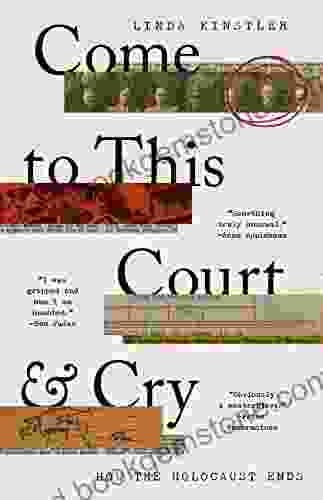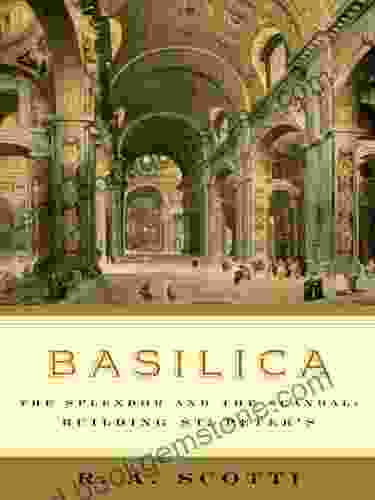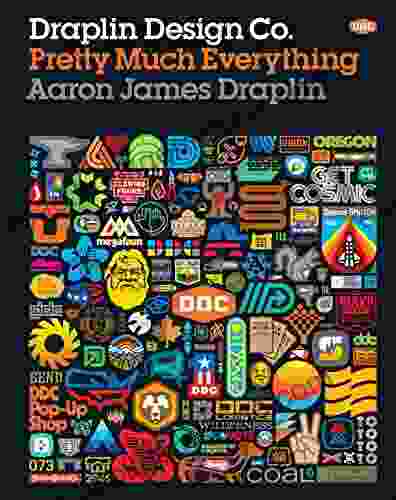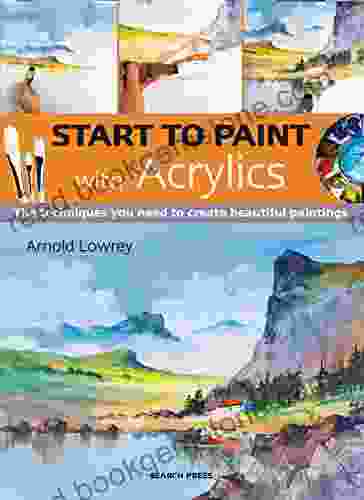Master the Art: A Comprehensive Guide to Painting Techniques for Stunning Masterpieces

: Unleashing Your Inner Artist
Painting is an art form that has the power to transcend the boundaries of language, evoking emotions and capturing the essence of life's most precious moments. Whether you're a seasoned artist or just beginning your journey on the canvas, understanding and mastering the fundamental techniques of painting is essential to creating captivating masterpieces that speak volumes.
4.3 out of 5
| Language | : | English |
| File size | : | 277542 KB |
| Screen Reader | : | Supported |
| Print length | : | 96 pages |
In this comprehensive guide, we will delve into the techniques that form the foundation of painting, empowering you to unlock your artistic potential and transform your creative visions into stunning works of art. From the nuances of color theory to the intricacies of composition, we will explore the principles that guide the creation of visually compelling paintings.
Chapter 1: The Alchemy of Color
Color is the lifeblood of painting, the vibrant palette that breathes life into our creations. Understanding color theory is paramount to mastering the art of painting.
1.1 Color Wheel: The Artist's Compass
The color wheel is the artist's compass, a visual representation of the relationships between colors. It presents the primary colors (red, yellow, and blue),secondary colors (green, orange, and violet),and tertiary colors (formed by mixing primary and secondary colors).
1.2 Color Harmony: Creating Visual Appeal
Color harmony is crucial for creating visually appealing compositions. Analogous color schemes use colors that are adjacent on the color wheel, while complementary color schemes employ colors that are opposite each other, creating contrast and visual impact.
1.3 Value and Tone: Shaping Light and Shadow
Value refers to the lightness or darkness of a color. Mastering value allows you to create depth and form by manipulating light and shadow. Tone is a variation of a color's value, adding subtle nuances to your paintings.
Chapter 2: The Canvas of Composition
Composition is the arrangement of elements within a painting to create a cohesive and visually pleasing whole. It determines the flow and balance of your artwork.
2.1 Rule of Thirds: A Guiding Principle
The rule of thirds divides the canvas into nine equal parts by two horizontal and two vertical lines. Placing important elements along these lines or at their intersections creates a balanced and dynamic composition.
2.2 Focal Point: The Heart of the Painting
Every painting should have a focal point, the area that draws the viewer's attention. Using contrasting colors, textures, or shapes can effectively direct the viewer's gaze.
2.3 Leading Lines: Guiding the Eye
Leading lines can guide the viewer's eye through the painting, creating a sense of movement and depth. Lines can be implied or explicit, leading the viewer from one element to another.
Chapter 3: The Virtuosity of Brushwork
Brushwork is the art of applying paint to the canvas using a variety of brushes. Different brushes and techniques can create distinct effects and textures.
3.1 Brush Types: An Artist's Toolkit
Various brush types serve specific purposes in painting. Round brushes are used for detailed work and blending, while flat brushes are ideal for creating broad areas of color.
3.2 Brush Techniques: From Soft to Bold
掌握各种笔触技术对于创造不同的效果至关重要。干刷可以产生纹理,而湿洗可以创造平滑的过度。涂抹和刮擦可以增加深度和复杂性。
Chapter 4: The Illusion of Space and Form
Creating the illusion of depth and form on a two-dimensional canvas is a hallmark of skilled painting.
4.1 Perspective: Creating Depth
Perspective allows artists to represent three-dimensional objects on a flat surface. Understanding linear and atmospheric perspective is essential for creating realistic depictions of space.
4.2 Value and Texture: Enhancing Realism
Value and texture work hand in hand to create the illusion of form. Contrasting values define the contours of objects, while texture adds surface details and visual interest.
Chapter 5: The Genres of Painting: Exploring Artistic Expression
Painting encompasses a wide range of genres, each with its own unique characteristics and techniques.
5.1 Still Life: Capturing the Essence of Objects
Still life painting involves depicting inanimate objects in a carefully arranged composition. Artists explore light, texture, and form to breathe life into everyday items.
5.2 Landscape: Embracing the Beauty of Nature
Landscape painting captures the essence of natural scenes, from sweeping vistas to serene meadows. Artists use color, composition, and perspective to convey the emotions and atmosphere of the landscape.
5.3 Portraiture: The Art of Capturing Human Emotion
Portraiture focuses on capturing the likeness, personality, and emotions of a human subject. Artists use a variety of techniques to convey the sitter's character and inner world.
Chapter 6: Artistic Inspiration: Igniting the Creative Mind
Inspiration fuels the creative process, providing artists with the ideas and emotions that translate onto the canvas.
6.1 Observation: The Source of Reality
Observation is a key source of inspiration. Studying the world around you, from nature to everyday objects, can spark ideas and provide valuable references for your paintings.
6.2 Emotion: The Power of Feeling
Emotions play a vital role in artistic expression. Allow your feelings to influence your color choices, brushwork, and composition to create paintings that resonate with viewers.
6.3 Inspiration from Others: Learning from Masters
Studying the works of great masters can inspire and inform your own artistic journey. Analyze their techniques, compositions, and use of color to learn and grow as an artist.
: The Artist's Journey
The journey of a painter is an ongoing process of exploration, discovery, and self-expression. By mastering the techniques outlined in this guide, you have embarked on a path that will lead you to create stunning paintings that captivate and inspire.
Remember, painting is not just about applying paint to a canvas; it is about expressing your unique voice, sharing your perspective, and creating works of art that touch the hearts and minds of viewers. Embrace the creative process, enjoy the journey, and let your imagination soar.
4.3 out of 5
| Language | : | English |
| File size | : | 277542 KB |
| Screen Reader | : | Supported |
| Print length | : | 96 pages |
Do you want to contribute by writing guest posts on this blog?
Please contact us and send us a resume of previous articles that you have written.
 Best Book
Best Book Page Flip
Page Flip Bookshelf
Bookshelf Literary loom
Literary loom Chapter
Chapter Bookish
Bookish PageTurner
PageTurner Bibliophile
Bibliophile Story
Story Inkwell
Inkwell Bookworm
Bookworm Labyrinth
Labyrinth Plot Twist
Plot Twist Prose
Prose Paperback
Paperback Storyteller
Storyteller Sanctuary
Sanctuary Fiction
Fiction Reading
Reading Chronicle
Chronicle Read
Read Lewis Hyde
Lewis Hyde Ted Riese
Ted Riese Lakia
Lakia Elizabeth Currie
Elizabeth Currie Charles Bowden
Charles Bowden S E Smith
S E Smith Casey Gerald
Casey Gerald Juliet Rieden
Juliet Rieden Audre Lorde
Audre Lorde Partha Mitter
Partha Mitter James Abell
James Abell John Hopkins
John Hopkins Karen Haid
Karen Haid Kresley Cole
Kresley Cole Jennifer Bohnet
Jennifer Bohnet Gary O Neal
Gary O Neal Shantiana Cooper
Shantiana Cooper Clive Cussler
Clive Cussler A C Crispin
A C Crispin Leo Kahl
Leo Kahl Dean Dalton
Dean Dalton Joseph Q Jarvis
Joseph Q Jarvis Sylvia D Lynch
Sylvia D Lynch Andres Lopez
Andres Lopez Brittany Gibbons
Brittany Gibbons Benedict Jacka
Benedict Jacka Jennifer Melville
Jennifer Melville Delia Gray Durant
Delia Gray Durant R H Sin
R H Sin Michael Gross
Michael Gross Collins Uk
Collins Uk Luis Tiant
Luis Tiant A K Duboff
A K Duboff Koloman Moser
Koloman Moser Donald Richie
Donald Richie Carl Little
Carl Little Brad Thor
Brad Thor Shelly Culbertson
Shelly Culbertson Gustavo Arellano
Gustavo Arellano John D Gartner
John D Gartner Mark Dery
Mark Dery Jane Alexander
Jane Alexander Phyllis Birnbaum
Phyllis Birnbaum Nick Athanas
Nick Athanas 1st Ed 2019 Edition Kindle Edition
1st Ed 2019 Edition Kindle Edition Christopher L Cirillo
Christopher L Cirillo Natasha Lawyer
Natasha Lawyer Goddess Love
Goddess Love Jeffrey Ford
Jeffrey Ford Ayano Otani
Ayano Otani Tao Wong
Tao Wong Mary Jane Walker
Mary Jane Walker Maureen Egan
Maureen Egan Cixin Liu
Cixin Liu Kelly Mills
Kelly Mills Michelle Vogel
Michelle Vogel Raymond Goodburn
Raymond Goodburn Ann Fisher
Ann Fisher Brandon Ellis
Brandon Ellis A M Sohma
A M Sohma A D Davies
A D Davies Diego Enrique Osorno
Diego Enrique Osorno Troy Denning
Troy Denning Mary Gabriel
Mary Gabriel Lina Chang
Lina Chang Megan Goldmine
Megan Goldmine Dustin Stevens
Dustin Stevens Porsha Williams
Porsha Williams Ann V Winterbotham
Ann V Winterbotham Tommaso Astarita
Tommaso Astarita Cazzie David
Cazzie David Ron Mcninch
Ron Mcninch Simon Scarrow
Simon Scarrow Suyi Davies Okungbowa
Suyi Davies Okungbowa Julie Metz
Julie Metz Jeffrey Alford
Jeffrey Alford Roberta Milliken
Roberta Milliken Matthew Poehler
Matthew Poehler Gautam Raghavan
Gautam Raghavan Giorgia Lupi
Giorgia Lupi Richard Kaufman
Richard Kaufman Margo Porras
Margo Porras Gary Heath
Gary Heath John E Siers
John E Siers Fernanda Melchor
Fernanda Melchor Gary Orleck
Gary Orleck Aisling Juanjuan Shen
Aisling Juanjuan Shen Gail Lukasik
Gail Lukasik Shvonne Latrice
Shvonne Latrice Dave Willmarth
Dave Willmarth Paraluman S Aspillera
Paraluman S Aspillera Paul Daugherty
Paul Daugherty Victor Godinez
Victor Godinez Aaron Bobrow Strain
Aaron Bobrow Strain Catherine Grace Katz
Catherine Grace Katz K Reynolds James
K Reynolds James Nanna Katrine Luders Kaalund
Nanna Katrine Luders Kaalund Maryanne Peters
Maryanne Peters Catherine Kapphahn
Catherine Kapphahn 3dtotal Publishing
3dtotal Publishing Leatrice Eiseman
Leatrice Eiseman Terrance Mulloy
Terrance Mulloy Tricia Martineau Wagner
Tricia Martineau Wagner Gary David Bouton
Gary David Bouton Christopher Ruocchio
Christopher Ruocchio Edmund De Waal
Edmund De Waal Leesa Cross Smith
Leesa Cross Smith Rebecca Vincent
Rebecca Vincent Jeffrey Wilson
Jeffrey Wilson John Marmysz
John Marmysz A Michael Shumate
A Michael Shumate Danielle Ofri
Danielle Ofri John Gimlette
John Gimlette Sam Tranum
Sam Tranum Beate Sirota Gordon
Beate Sirota Gordon Shirlene Obuobi
Shirlene Obuobi Rich Horton
Rich Horton Ernest Chesneau
Ernest Chesneau Ethan De Seife
Ethan De Seife Harry Turtledove
Harry Turtledove Jesse Day
Jesse Day Scotia Gilroy
Scotia Gilroy Terence Biffi
Terence Biffi Birnbaum Guides
Birnbaum Guides Kamo
Kamo Yihui Xie
Yihui Xie Lisa Jackson
Lisa Jackson Andrew Crone
Andrew Crone J T Brannan
J T Brannan Renato Perdon
Renato Perdon Ranim Nourallah
Ranim Nourallah Joseph Farrell
Joseph Farrell Paul C Middleton
Paul C Middleton Neil Hutchison
Neil Hutchison Ava Ross
Ava Ross Noah Scalin
Noah Scalin Karen Speerstra
Karen Speerstra A R Burns
A R Burns Anne Strathie
Anne Strathie Ray Loriga
Ray Loriga Valeria Luiselli
Valeria Luiselli Cynthia Knox
Cynthia Knox Garry Apgar
Garry Apgar Tenzin Priyadarshi
Tenzin Priyadarshi Susan Veness
Susan Veness Sean Willson
Sean Willson Madeleine Korbel Albright
Madeleine Korbel Albright Shannon Leone Fowler
Shannon Leone Fowler Beth Reiber
Beth Reiber Darra Goldstein
Darra Goldstein Ann Fensterstock
Ann Fensterstock Seth Ring
Seth Ring Clint Salter
Clint Salter Editors Of Creative Publishing International
Editors Of Creative Publishing International Emily Gosling
Emily Gosling Maxim D Shrayer
Maxim D Shrayer Zen Cho
Zen Cho Bill Gardner
Bill Gardner Javier Zamora
Javier Zamora Etienne De Backer
Etienne De Backer Jill Santopolo
Jill Santopolo Dami Lee
Dami Lee Jen Santos
Jen Santos Michael A Almond
Michael A Almond Gay Talese
Gay Talese Jenell Diegor
Jenell Diegor Amanda Conner
Amanda Conner W David Baird
W David Baird S M Warlow
S M Warlow Peter Watts
Peter Watts Dannion Brinkley
Dannion Brinkley Catherine Belsey
Catherine Belsey Peter A Koenig
Peter A Koenig Trice Hickman
Trice Hickman Michelle Knight
Michelle Knight Natasha Brown
Natasha Brown A R Corbin
A R Corbin Sambou Kamissoko
Sambou Kamissoko Bill Robinson
Bill Robinson Shellise Berry
Shellise Berry David Lewis
David Lewis Salvador Dali
Salvador Dali Stanley Green
Stanley Green Dawn Loring
Dawn Loring Tania Romanov
Tania Romanov Todd Mcgowan
Todd Mcgowan Gregory Crouch
Gregory Crouch Monica Peach
Monica Peach Chris Hechtl
Chris Hechtl Kitiara Pascoe
Kitiara Pascoe Tony Corden
Tony Corden Marina Abramovic
Marina Abramovic Walter Crane
Walter Crane Ralph Ellison
Ralph Ellison C J Cherryh
C J Cherryh Brant Antonson
Brant Antonson Jack Womack
Jack Womack Brette Sember
Brette Sember Joseph M Mascia
Joseph M Mascia Shana Vanterpool
Shana Vanterpool Tony Spawforth
Tony Spawforth Melissa Fu
Melissa Fu James Egan
James Egan Richard Wagamese
Richard Wagamese Maggie Black
Maggie Black Lisa Ohlen Harris
Lisa Ohlen Harris Eduardo F Calcines
Eduardo F Calcines Mo Yan
Mo Yan Jung Yun
Jung Yun Jessica Augustsson
Jessica Augustsson Bob Kaufman
Bob Kaufman Alex Kosh
Alex Kosh Lisa Rose Wright
Lisa Rose Wright Jeffrey Eugenides
Jeffrey Eugenides Glennon Doyle
Glennon Doyle Isabella Decarlo
Isabella Decarlo Stephen Farthing
Stephen Farthing Vicky Unwin
Vicky Unwin Daniel Sheets Dye
Daniel Sheets Dye Justin Catanoso
Justin Catanoso David Blacklock
David Blacklock Richard F Fleck
Richard F Fleck Michael Wigge
Michael Wigge John F Callahan
John F Callahan Tracey Cohen
Tracey Cohen Alex Stone
Alex Stone Heather Webb
Heather Webb Amarilys Henderson
Amarilys Henderson Anuj Tikku
Anuj Tikku Charles Harrison
Charles Harrison Kate Sekules
Kate Sekules Lynn Michelsohn
Lynn Michelsohn 1st Edition Kindle Edition
1st Edition Kindle Edition Sam Hampton Smith
Sam Hampton Smith Nathan Brown
Nathan Brown Joe Upton
Joe Upton Rowland B Wilson
Rowland B Wilson Derek Hough
Derek Hough Marjorie Lambert
Marjorie Lambert Joanna Merlin
Joanna Merlin Tim Lebbon
Tim Lebbon Jan Gaye
Jan Gaye Arnold Lowrey
Arnold Lowrey Daniel Mathews
Daniel Mathews Charles Johnson
Charles Johnson Richard Taylor
Richard Taylor Heather Young
Heather Young Robin Barratt
Robin Barratt Selena Montgomery
Selena Montgomery Mamie Till Mobley
Mamie Till Mobley William F Powell
William F Powell Jo Charnock
Jo Charnock V S Naipaul
V S Naipaul Mary Prince
Mary Prince Robert E Kapsis
Robert E Kapsis Jeaniene Frost
Jeaniene Frost John Edson
John Edson Daniel Van
Daniel Van Jay Boyce
Jay Boyce Helen Raleigh
Helen Raleigh Douglas E Richards
Douglas E Richards Ray Balkwill
Ray Balkwill Michael Crichton
Michael Crichton K Kris Loomis
K Kris Loomis Megan Mackie
Megan Mackie Sharon Shinn
Sharon Shinn David Feintuch
David Feintuch David Bergsland
David Bergsland Dk
Dk Carlos Simpson
Carlos Simpson Joshua Bloom
Joshua Bloom A F Kay
A F Kay Alison C Board
Alison C Board R W W Greene
R W W Greene A S Byatt
A S Byatt Cyrus Massoudi
Cyrus Massoudi Maisy Card
Maisy Card A A Villescas
A A Villescas William O Connor
William O Connor Victor Steffensen
Victor Steffensen Toby Neighbors
Toby Neighbors Aaron Fine
Aaron Fine Greg Sarris
Greg Sarris Tina Martin
Tina Martin Julia Elizabeth Sloan
Julia Elizabeth Sloan Sam J Miller
Sam J Miller Phylis Johnson
Phylis Johnson Bruce Scivally
Bruce Scivally Douglas Dorow
Douglas Dorow Reginald Fleming Johnston
Reginald Fleming Johnston Kenneth Clark
Kenneth Clark Philippe Chantepie
Philippe Chantepie Paul Hill
Paul Hill Rosemary Edghill
Rosemary Edghill Penelope Douglas
Penelope Douglas Blake Gopnik
Blake Gopnik Jhumpa Lahiri
Jhumpa Lahiri Mari Sandoz
Mari Sandoz Joanna Kulesza
Joanna Kulesza Tarana Burke
Tarana Burke A J Alonzo Wind
A J Alonzo Wind Christa Upton
Christa Upton T Ann Marie
T Ann Marie Koichi Hagawa
Koichi Hagawa Andy Fletcher
Andy Fletcher Sean Michael Andrews
Sean Michael Andrews Calvin Tomkins
Calvin Tomkins Alexandre Roger
Alexandre Roger Chris Backe
Chris Backe Reed Tucker
Reed Tucker E Train Learning
E Train Learning Mary Kubica
Mary Kubica Sarah Bird
Sarah Bird Laura Shumaker
Laura Shumaker Lawrence F Lihosit
Lawrence F Lihosit Agathe Singer
Agathe Singer Donald B Mcfarlane
Donald B Mcfarlane David Parker
David Parker Brandi Carlile
Brandi Carlile Stan Zimmerman
Stan Zimmerman Aileen Bordman
Aileen Bordman William Middleton
William Middleton Scott Peters
Scott Peters Mazie K Hirono
Mazie K Hirono David Elliot Cohen
David Elliot Cohen Susan R Barry
Susan R Barry Elsebeth Lavold
Elsebeth Lavold Joel Paul Reisig
Joel Paul Reisig Julian Barnes
Julian Barnes Ann Patchett
Ann Patchett Samantha Seiple
Samantha Seiple Christopher Ingraham
Christopher Ingraham Scott Lunt
Scott Lunt Charissa N Terranova
Charissa N Terranova Nigel Cross
Nigel Cross Pete Buckley
Pete Buckley Erwin Rosenthal
Erwin Rosenthal Mark Greaney
Mark Greaney Michael Brooke
Michael Brooke Trevor Norton
Trevor Norton Victoria Buitron
Victoria Buitron Peter Rush
Peter Rush Ben Ryan
Ben Ryan David Garner
David Garner Tori Harris
Tori Harris Tyrel Nelson
Tyrel Nelson 1st Ed 2018 Edition Kindle Edition
1st Ed 2018 Edition Kindle Edition Michael Roberts
Michael Roberts Nawar Shora
Nawar Shora Alyssa Cole
Alyssa Cole Shemer Kuznits
Shemer Kuznits Jenny Mcgill
Jenny Mcgill Deborah Hay
Deborah Hay Colin Post
Colin Post Doug Risner
Doug Risner A J Finn
A J Finn Steve Gladstone
Steve Gladstone Steve Kaffen
Steve Kaffen Actus
Actus Jules Gailhabaud
Jules Gailhabaud Janice Dean Willis
Janice Dean Willis Alberta Arthurs
Alberta Arthurs Brad Warner
Brad Warner Jeff Howard
Jeff Howard Charles Alexander Eastman
Charles Alexander Eastman Chris Bond
Chris Bond Jennifer Rosner
Jennifer Rosner Roger Williams
Roger Williams Margo Bond Collins
Margo Bond Collins Christopher Fowler
Christopher Fowler Bob Sehlinger
Bob Sehlinger Olympia Black
Olympia Black Belinda Jones
Belinda Jones Fred Crellin
Fred Crellin Bryony Gomez Palacio
Bryony Gomez Palacio Michael Bierut
Michael Bierut Cecelia Dowdy
Cecelia Dowdy Elena Ferro
Elena Ferro Carrie Prudence Winter
Carrie Prudence Winter Henry Dreyfuss
Henry Dreyfuss Maria Sibylla Merian
Maria Sibylla Merian Meyer Levin
Meyer Levin Diana Marcum
Diana Marcum Larry Niven
Larry Niven Shira Lipkin
Shira Lipkin Linda Kinstler
Linda Kinstler Rose Gonnella
Rose Gonnella Nick Jones
Nick Jones Dani Cavallaro
Dani Cavallaro Anne Wheeler
Anne Wheeler Mosy Brigth
Mosy Brigth Weijian Shan
Weijian Shan Marlon James
Marlon James Sarah Torrecillas
Sarah Torrecillas Michael Petrou
Michael Petrou Aaris Sherin
Aaris Sherin M P Woodward
M P Woodward Thom Wall
Thom Wall Negar Mottahedeh
Negar Mottahedeh Laura J Mixon
Laura J Mixon David Sipress
David Sipress Hilary Hughes Loftus
Hilary Hughes Loftus David Nabhan
David Nabhan Annalyn Swan
Annalyn Swan Ken Liu
Ken Liu Graham Fraser
Graham Fraser Aabis Johnson
Aabis Johnson Stephen Haddelsey
Stephen Haddelsey Christopher James
Christopher James Donald Bogle
Donald Bogle Tony Barr
Tony Barr Noah Brooks
Noah Brooks Judy O Haselhoef
Judy O Haselhoef Robert Fleming
Robert Fleming Gregory Mirow
Gregory Mirow Rebecca Dwight Bruff
Rebecca Dwight Bruff Bridget Quinn
Bridget Quinn Bwwm Club
Bwwm Club Andy Clark
Andy Clark R A Scotti
R A Scotti Andrew Forkner
Andrew Forkner Bruce Sentar
Bruce Sentar Belle Yang
Belle Yang Michael F Keaney
Michael F Keaney Eddie Lennon
Eddie Lennon Martha Wainwright
Martha Wainwright A Desaint
A Desaint Pierre Alex Jeanty
Pierre Alex Jeanty C C Alma
C C Alma Harmony Bench
Harmony Bench Carma Gorman
Carma Gorman Peter Swanson
Peter Swanson Bruce Carroll
Bruce Carroll Gary Phillips
Gary Phillips Marina Berkovich
Marina Berkovich Brian J Robb
Brian J Robb Juno Wells
Juno Wells Nicole Koetter
Nicole Koetter James Robert
James Robert Gary Earl Ross
Gary Earl Ross Dale Brown
Dale Brown Linea Johnson
Linea Johnson Fred Arroyo
Fred Arroyo Jarrett Wrisley
Jarrett Wrisley A C Arthur
A C Arthur Paul Norbury
Paul Norbury Luther Standing Bear
Luther Standing Bear A Sanguineti
A Sanguineti James Just
James Just Ramze Suliman
Ramze Suliman Karin Tanabe
Karin Tanabe Janice Cavell
Janice Cavell Tom Cotter
Tom Cotter Laurence Matthews
Laurence Matthews Laura Lee Fritz
Laura Lee Fritz Bernie Schein
Bernie Schein Aaron James Draplin
Aaron James Draplin Jonathan Harr
Jonathan Harr Dale Sherman
Dale Sherman James M Mcpherson
James M Mcpherson Daniel Jacobs
Daniel Jacobs Dmitry Samarov
Dmitry Samarov Peter Cozzens
Peter Cozzens Tara Bray Smith
Tara Bray Smith Mark Harris
Mark Harris J D Sullivan
J D Sullivan John Christian Hopkins
John Christian Hopkins Susie Kalil
Susie Kalil M N Forgy
M N Forgy Christine Skwiot
Christine Skwiot Thomas Lockwood
Thomas Lockwood Theophilus Monroe
Theophilus Monroe Mary Jane Houlton
Mary Jane Houlton Morgan Jerkins
Morgan Jerkins Robert S Birchard
Robert S Birchard Ina Knobloch
Ina Knobloch J C Cannell
J C Cannell Greydon Clark
Greydon Clark Nick Iuppa
Nick Iuppa Jennifer Natalya Fink
Jennifer Natalya Fink Melverna Mcfarlane
Melverna Mcfarlane Kira Salak
Kira Salak Brian Morton
Brian Morton Richard Condit
Richard Condit Winki
Winki Nikki Giovanni
Nikki Giovanni Alexander William Kinglake
Alexander William Kinglake Soon Y Warren
Soon Y Warren Laurie Gwen Shapiro
Laurie Gwen Shapiro Erin Khar
Erin Khar Catie Marron
Catie Marron Sheila Weller
Sheila Weller Leonard Peltier
Leonard Peltier Paolo Hewitt
Paolo Hewitt Octavia E Butler
Octavia E Butler S L Partee
S L Partee Adam Bray
Adam Bray Aimee Song
Aimee Song Sarah Fraser
Sarah Fraser C Napier Bell
C Napier Bell Joseph D Addetta
Joseph D Addetta A American
A American Nek Hickmon
Nek Hickmon William Bennet Stevenson
William Bennet Stevenson Rocky Nielsen
Rocky Nielsen Burt Wrenlaw
Burt Wrenlaw Henri Piquer
Henri Piquer Andre Iguodala
Andre Iguodala Kate Clifford Larson
Kate Clifford Larson Darren Royston
Darren Royston Bernardine Evaristo
Bernardine Evaristo Mark J Rose
Mark J Rose 2nd Edition Kindle Edition
2nd Edition Kindle Edition Deby Coles
Deby Coles Daniel Gordis
Daniel Gordis David Gentleman
David Gentleman Victor Margolin
Victor Margolin Carol Boyle
Carol Boyle Dwight Roth
Dwight Roth Jane M Newby
Jane M Newby Lindsay Buroker
Lindsay Buroker Dave Austin
Dave Austin Chris Robinson
Chris Robinson Guidora Team
Guidora Team Henry White
Henry White Barbara Barrett
Barbara Barrett David Cousens
David Cousens Larry Moss
Larry Moss Jeff A Menges
Jeff A Menges Robyn Wideman
Robyn Wideman Donna Digiuseppe
Donna Digiuseppe Aaron Dembski Bowden
Aaron Dembski Bowden Leslie Cabarga
Leslie Cabarga Alex W White
Alex W White Roxie Mcclaine
Roxie Mcclaine Mark Jones
Mark Jones Kathy Arlyn Sokol
Kathy Arlyn Sokol Marina Jarre
Marina Jarre Zoe Ingram
Zoe Ingram Soraya French
Soraya French Stephen Powell
Stephen Powell Cynthia Sax
Cynthia Sax Bob Chapman
Bob Chapman Laura L Engel
Laura L Engel Aaron Barron
Aaron Barron Alta Macadam
Alta Macadam Debra Meyerson
Debra Meyerson Michael C Grumley
Michael C Grumley Shaa Fazal
Shaa Fazal Charles Barr
Charles Barr Jane Allen Petrick
Jane Allen Petrick James Willard Schultz
James Willard Schultz R Allen Hardy
R Allen Hardy Jack Hunt
Jack Hunt Sarah Noffke
Sarah Noffke Lisa Maker
Lisa Maker Elizabeth Strout
Elizabeth Strout Gerald Shea
Gerald Shea John Cheever
John Cheever Alastair Campbell
Alastair Campbell Jon Tucker
Jon Tucker Sylvester Murray
Sylvester Murray Stephen Chambers
Stephen Chambers Thais Riotto
Thais Riotto J B Bobo
J B Bobo Sabra Waldfogel
Sabra Waldfogel Tom Sullivan
Tom Sullivan Neil A Hogan
Neil A Hogan Kate Clair
Kate Clair Maud Fontenoy
Maud Fontenoy Roman Plesky
Roman Plesky James Osiris Baldwin
James Osiris Baldwin Elizabeth Kendall
Elizabeth Kendall Don Croner
Don Croner Bill Neeley
Bill Neeley Kaylie Kay
Kaylie Kay Yanis Varoufakis
Yanis Varoufakis Stephanie Thornton
Stephanie Thornton Merick N H Ulrik
Merick N H Ulrik Rachel Woods
Rachel Woods Brandon Sanderson
Brandon Sanderson Charles Foran
Charles Foran Ernest R Norling
Ernest R Norling Danny Garcia
Danny Garcia Patricia Bjaaland Welch
Patricia Bjaaland Welch Kate Langbroek
Kate Langbroek Ruth Millington
Ruth Millington Marie Arana
Marie Arana Jeremy Hicks
Jeremy Hicks Rhys Bowen
Rhys Bowen Cora Harrington
Cora Harrington Julia Whelan
Julia Whelan David Batchelor
David Batchelor Mel Laytner
Mel Laytner Walter Jon Williams
Walter Jon Williams Edward Leo
Edward Leo Dean Simmons
Dean Simmons Robert Shufflebotham
Robert Shufflebotham A P Bateman
A P Bateman David Newton
David Newton David Hinton
David Hinton Dean C Moore
Dean C Moore Trevor Boffone
Trevor Boffone Paul Austin Ardoin
Paul Austin Ardoin Tonya Burrows
Tonya Burrows Jihyun Park
Jihyun Park Joshua Samuel Brown
Joshua Samuel Brown Insight Traveller
Insight Traveller J M Phillips
J M Phillips Kathleen Jones
Kathleen Jones Yvonne Wakefield
Yvonne Wakefield Alison Bechdel
Alison Bechdel Jit Baral
Jit Baral Shannon Pemrick
Shannon Pemrick Rosalind Rosenberg
Rosalind Rosenberg Sara Novic
Sara Novic Natasha Sims
Natasha Sims Stephen Baxter
Stephen Baxter Diana K Schwam
Diana K Schwam Shawna Sharee
Shawna Sharee Dean Wesley Smith
Dean Wesley Smith Daniel Tudor
Daniel Tudor Martin Fletcher
Martin Fletcher Heinrich Klutschak
Heinrich Klutschak Paul R Wonning
Paul R Wonning Joan Wiener Bordow
Joan Wiener Bordow David Hornung
David Hornung Barbara Newton
Barbara Newton
Light bulbAdvertise smarter! Our strategic ad space ensures maximum exposure. Reserve your spot today!
 Herb SimmonsFollow ·7.1k
Herb SimmonsFollow ·7.1k Terry BellFollow ·18.6k
Terry BellFollow ·18.6k Ian MitchellFollow ·16k
Ian MitchellFollow ·16k Haruki MurakamiFollow ·15.8k
Haruki MurakamiFollow ·15.8k Wayne CarterFollow ·5.7k
Wayne CarterFollow ·5.7k Elton HayesFollow ·5.5k
Elton HayesFollow ·5.5k Rubén DaríoFollow ·11.4k
Rubén DaríoFollow ·11.4k Cruz SimmonsFollow ·14.5k
Cruz SimmonsFollow ·14.5k

 Lucas Reed
Lucas ReedFantasy Technology and Politics: A Deep Dive into the...
Fantasy literature...

 Blake Kennedy
Blake KennedyCome To This Court And Cry: A Tale of Love, Loss, and...
Come To This Court And Cry...

 Kendall Ward
Kendall WardThe Majestic Edifice: Exploring the History and...
St. Peter's Basilica, an architectural...

 Emmett Mitchell
Emmett MitchellDraplin Design Co.: Pretty Much Everything
Who is Draplin Design Co.? Draplin Design...

 Eliot Foster
Eliot FosterUnveiling the Enthralling Literary Cosmos of Against Time...
Prologue: A Quantum Nexus of Time and...

 Connor Mitchell
Connor MitchellMy Journey Through the Labyrinth of Low-Budget...
In the enthralling realm of filmmaking,...
4.3 out of 5
| Language | : | English |
| File size | : | 277542 KB |
| Screen Reader | : | Supported |
| Print length | : | 96 pages |












